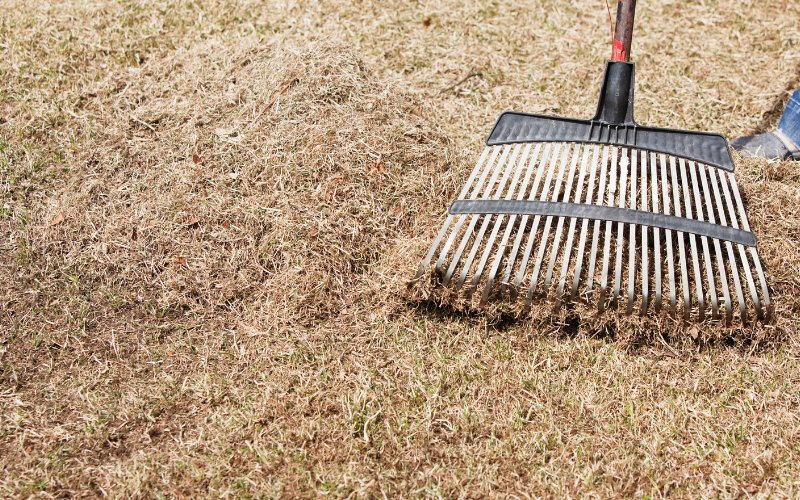If your lawn looks like a total mess after dethatching, you’re not alone. Anyone who has dethatched a lawn has been there. At some level, this is expected. However, that doesn’t mean you can ignore the critical aftercare necessary if and when you choose to dethatch your lawn.
Further, there are dethatching mistakes you can make that will make your lawn look worse than it should. You can learn about all of this in the article below.

Why Does My Lawn Look So Bad After Dethatching? (The Short Answer)
So your lawn looks bad after dethatching? This is entirely normal. During the process of dethatching, an important layer of your lawn is being stirred up, cut, and some of it will be removed entirely. This results in a lawn that will look a little ragged for up to a week. However, it’s also possible to take dethatching too far.
5 Possible Reasons Your Lawn May Look Terrible After Dethatching
Below are 5 reasons why your lawn looks bad after dethatching and why these things are a problem.
The Weather Was Wrong for Dethatching a Lawn
You do not want to dethatch a lawn if it has rained in the last 2 to 3 days, depending on how well your soil drains. Dethatching while the top 4 inches of your soil are excessively wet can lead to the roots of your lawn shifting around or being more easily pulled out during the dethatching process.
On the flip side, you do not want to dethatch during excessively hot weather or drought. You want your lawn to be well within its growing temperature range to prevent and recover from damage.
Your Lawn Was Dormant Before You Dethatched
Dethatching while your lawn is dormant will cause damage that is not easy to repair. First, if you dethatch in late fall or early winter as your lawn is just entering dormancy, you may rip up roots and other nutrient-holding structures, resulting in large swaths of dead grass over the winter and into the spring.
If you dethatch early in the spring before your lawn fully comes out of its dormant state, you may still damage these roots and structures, but the real danger is in stirring up and making room for weeds.
If you dethatch in early spring you can create open spots for newly stirred-up seeds to settle. These seeds could, for example, lead to a crabgrass infestation as crabgrass sprouts will come out of dormancy before most established types of turfgrass.
These weedy patches can make your lawn look rough and uneven, even after the primary damage caused by dethatching is healed.
Removing More Than Just Thatch
If your lawn had a thatch layer of less than 1/2” or you happened to use a tool meant for much more thatch than you have, it’s possible that while you meant to only remove the top of your thatch layer, what you actually removed was much more.
This is a common occurrence if you are unfamiliar with the automatic cutting or dethatching machine that you chose to use. Not all dethatching machines are the same or meant for the same levels of thatch.
There Wasn’t Enough Thatch to Begin With
You never want to remove all of the thatch from your lawn. Thatch is there for a reason. It helps insulate the roots of your grass from damage caused by digging animals and bugs. It can help your lawn retain moisture and it acts as a buffer to hold nutrients and prevent your lawn from burning if too much fertilizer is applied. It can also help your lawn maintain a neutral pH.
The ideal level of thatch is 1/2” in thickness. Unless the thatch layer is more than 3/4” when compressed and measured, you don’t need to dethatch. Doing so will cause more harm than good.
Your Lawn Was Unhealthy Before Dethatching
If none of the above reasons apply to your situation, there was likely something wrong with your lawn that has now gained a foothold. This could be a disease, a moisture-related issue, or a nutrient issue.
How to Fix a Lawn That Looks Bad After Dethatching (3 Things to Try)
All you can do after dethatching and ending up with a mess is support your remaining lawn as best you can.
Smooth Your Lawn + Rake Up and Remove Any Loose Grass or Thatch
To get the best possible idea of where you’re starting from, gently rake up any loose grass or thatch and move it to a compost pile or yard waste bin. This allows you to prevent further damage from the thatch, as it can smother the grass underneath and allows you to see what’s left of your lawn.
You can also use this time to gently smooth over any gouges or places where the lawn may have been cut too deeply during the dethatching process.
Water and Fertilize Your Lawn After Dethatching
After dethatching, even if everything was done perfectly, your lawn will have been cut up enough to need more nutrients and water to heal itself. Depending on your feeding schedule and local climate, what you need to supplement will vary greatly.
However, as a general rule, a light scattering of slow-release fertilizer in the week following a dethatching treatment, if none has been applied in the last 3 months, is a great start. Applying half again as much water as you typically use in a week for up to 3 weeks after you dethatch is also recommended.
Overseed or Re-plant Any Damaged Areas of Your Lawn After Dethatching
Depending on the type of turf you have, you should either reseed or cut and re-plant plugs in any areas that are struggling. Generally, reseeding is a good and inexpensive way to help your lawn look better as quickly as it can and those new grass seedlings can help out-compete weed seeds in any newly-cleared spots in your lawn.


Leave a Reply